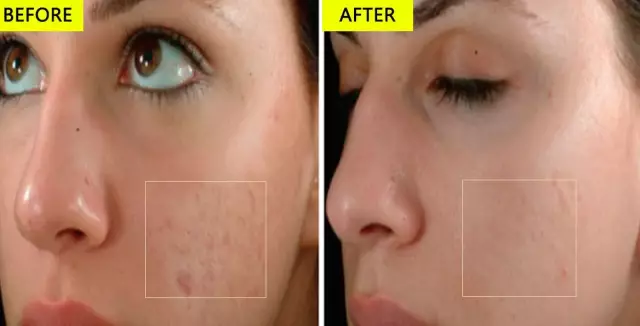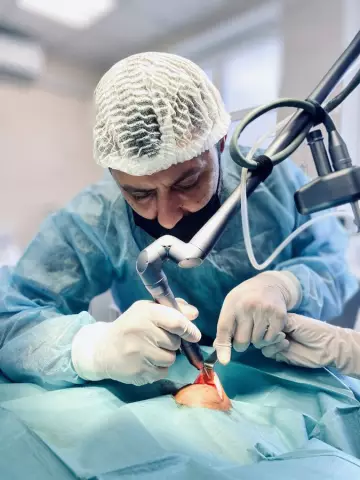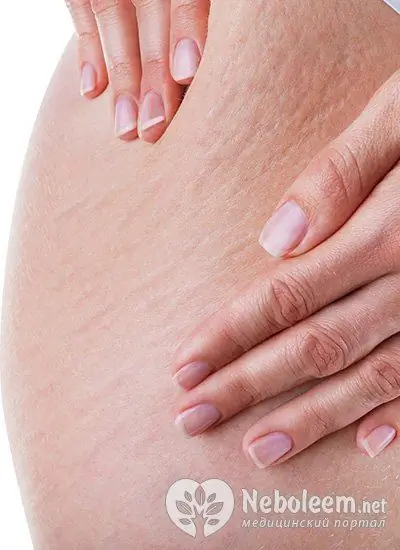- Author Rachel Wainwright [email protected].
- Public 2023-12-15 07:39.
- Last modified 2025-11-02 20:14.
Removal of scars

A scar is the common name for a scar, which, in turn, is a dense formation of connective tissue. A scar occurs during regeneration after damage or inflammation of internal or external organs. But when we talk about scars, we mean, as a rule, large, visible to the naked eye violations of the integrity of the skin, which represent a clear cosmetic defect. Not surprisingly, most people (mostly women) seek to get rid of them. Today, there are both special preparations and cosmetic procedures for this. Next, we will look at how scars are removed and what is used for this.
What is a scar (scar)
The body of the scar is composed of collagen and differs significantly in structure from the tissue it replaces. The scar does not have the same function, it is more sensitive to UV radiation, and it cannot contain sweat glands or hair follicles. After the wound heals with normal scarring, a normotrophic scar can form - it is located at the same level with the skin, has elasticity, pale or flesh color, does not violate the sensitivity of the skin, in a word, it remains practically invisible. According to reviews, the removal of this type of scars is almost not required.
When the wound healing process is impaired, atrophic, hypertrophic and keloid scars can form. And in this case, it is possible that scars will need to be removed. An atrophic scar is located below the level of the skin, it is thinner and flabby in structure, its color is lighter than that of healthy tissue. A typical example is scars after stretch marks and acne.
Hypertrophic scars form with excess connective tissue and protrude above the surface of the skin. They are much less elastic than the healthy dermis, and are darker (ranging in color from pink to purple), may itch or be uncomfortable to touch, but are usually painless. Over time, this type of scar can almost completely regress. A typical example is a scar after surgery, trauma, burns, severe inflammation. Removal of the scar in this case is usually successful.
Keloid scars of a purple-cyanotic color with a shiny and bumpy surface are one of the unpleasant complications of the wound healing process. Scars of this type protrude strongly above the level of the skin, often cause itching, pain, cause one or another discomfort. The scar tissue grows uncontrollably even after healing and continues to grow for many years. According to reviews, removal of this type of scars cannot completely rule out recurrence. A keloid scar is formed from minor injuries such as ear piercing, tattooing, trivial scratches, but can be several times larger than the size of the wound itself.
Surgical removal of scars
Serious skin lesions as a result of trauma, wounds, burns, complicated inflammatory processes lead to the formation of large scars. Sometimes the only way to remove scars, according to experts, in this case is plastic surgery or, more simply, excision. It should be remembered that any surgical intervention leaves scars, in this case they will be less noticeable than the original one. Surgical removal of scars can reduce the width and depth of the scar, remove foreign particles, or move the scarring process to a more hidden area.
At the time of the operation, the surgeon excises the body of the scar, cauterizes the vessels, mobilizes and sutures the wound edges. It turns out a Z-shaped seam.
In fact, there are quite a few ways to remove scars, for example, the following:
- Scar plasty with the imposition of a cosmetic intradermal suture;
- Plastic surgery with changing the contour of the scar;
- Plastic surgery with skin grafting;
- Plastic with an expander to remove deep, extensive scars.
When treating scars of a hypertrophic nature, the prognosis is always positive, it seems more difficult to eliminate keloid scars, since they recur in 50-80% of cases.
After plastic surgery, a pressure bandage is applied to the suture area for a day, for some time the patient is advised to avoid direct sunlight and tissue tension.
Gentle scar removal methods
If the scar is not as extensive and deep, less invasive methods can be applied to it than excision, for example, laser resurfacing or microdermabrasion.
Laser scar removal is one of the most common procedures performed in beauty parlors. It consists in layer-by-layer resurfacing of the scar body with a laser apparatus. Within a few days after laser removal of the scar, swelling and soreness may occur in the area of the scar, at this point it is important to prevent inflammation. For this purpose, antimicrobial drugs and agents to improve local blood circulation can be prescribed. A thin crust forms at the site of the operation; it usually disappears naturally by 7-8 days after the operation.
Laser removal of scars is most effective for normotrophic scars. Hypertrophic scars are a little more difficult to treat; they require several sessions. According to reviews, the removal of keloid-type scars by laser correction is considered inappropriate, and if the doctor nevertheless agreed, it is combined with drug therapy.
Laser scar removal is a relatively expensive but safe procedure that only affects the top layers of the skin. After the session, you should refuse any cosmetic procedures, including visiting the solarium and sunbathing. If the scar is in an open area, it is treated with sunscreen.

Microdermabrasion is the removal of scars by mechanical leveling of the skin's relief. The procedure can be carried out using a sandblaster, ultrasound, or a combination of a jet of water and gas. Its feature is the dosed and targeted smoothing of the areas of scar tissue that need it most. Reviews on the removal of scars indicate that such a cosmetic manipulation is much preferable to peeling. But depending on the size of the scar and the type of procedure, it may take 10 to 30 sessions.
Medical scar removal
And yet, for many patients, cosmetic procedures are uncomfortable, while they would just like to apply some kind of ointment to the skin and forget about the scar. And there are such funds. If the scar is large and fresh enough, then a special scar removal cream will help to remove it. Currently, dozens of suitable drugs are presented on the domestic pharmaceutical market, however, before using them, it is worth consulting a dermatologist. As a rule, a cream for removing scars requires systematic application for 3-4 months. These drugs can be used to treat stretch marks, acne scars, and even postoperative scars. The earlier the patient starts treatment, the more effective the effect of the cream will be in the end to remove scars.
Found a mistake in the text? Select it and press Ctrl + Enter.






